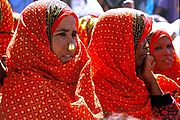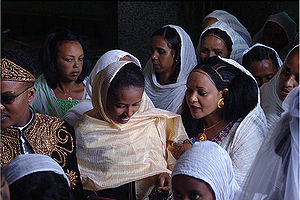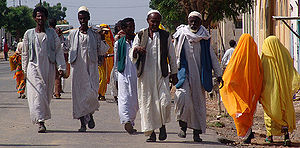
Demographics of Eritrea
Encyclopedia

Eritrea
Eritrea , officially the State of Eritrea, is a country in the Horn of Africa. Eritrea derives it's name from the Greek word Erethria, meaning 'red land'. The capital is Asmara. It is bordered by Sudan in the west, Ethiopia in the south, and Djibouti in the southeast...
's inhabitants. Demographic topics include basic education, health and population statistics, as well as identified ethnic and religious affiliations.
Ethnic groups

Tigre people
The Tigre are an ethnic group residing in Eritrea and Sudan. They are a nomadic and pastoralist people, related to the Tigray-Tigrinya people of Eritrea and Ethiopia and to the Beja people of Sudan.-History:...
make up about 30% of the population. These form the bulk of the country's predominantly Semitic
Semitic languages
The Semitic languages are a group of related languages whose living representatives are spoken by more than 270 million people across much of the Middle East, North Africa and the Horn of Africa...
-speaking population.
Most of the rest of the population belong to other Afro-Asiatic
Afro-Asiatic languages
The Afroasiatic languages , also known as Hamito-Semitic, constitute one of the world's largest language families, with about 375 living languages...
-speaking communities of the Cushitic
Cushitic languages
The Cushitic languages are a branch of the Afroasiatic language family spoken in the Horn of Africa, Tanzania, Kenya, Sudan and Egypt. They are named after the Biblical character Cush, who was identified as an ancestor of the speakers of these specific languages as early as AD 947...
branch, such as the Saho
Saho people
The Saho , sometimes called Soho, are an ethnic group living largely in the Horn of Africa. They are principally concentrated in the Southern and Northern Red Sea regions of Eritrea, but some also live in adjacent parts of Ethiopia.-Demographics:...
, Hedareb
Hedareb people
The Hedareb people include the Beni-Amer people who have retained the use of the Beja language, the To-Bedawi . They also include the subtribes: Hashish, Labat, and Halenqua...
, Afar
Afar people
The Afar , also known as the Danakil, are an ethnic group in the Horn of Africa. They primarily live in the Afar Region of Ethiopia and in northern Djibouti, although some also inhabit the southern point of Eritrea.-Early history:...
and Bilen
Bilen people
The Bilen, Blin or Bilin, also known as the Bogo or North Agaw, are an ethnic group in the Horn of Africa. They are primarily concentrated in central Eritrea, in and around the city of Keren, and south toward Asmara, the nation's capital.-Overview:Some of the Bilen entered Eritrea from Ethiopia...
.
There are also a number of Nilotic
Nilotic
Nilotic people or Nilotes, in its contemporary usage, refers to some ethnic groups mainly in South Sudan, Uganda, Kenya, and northern Tanzania, who speak Nilotic languages, a large sub-group of the Nilo-Saharan languages...
ethnic minorities who are represented in Eritrea by the Kunama
Kunama people
The Kunama are a Nilotic people living in Eritrea and Ethiopia. 80% of Kunamas live in Eritrea yet make up only 2 percent of the population of Eritrea, where they are one of the smallest ethnic groups. Most of the estimated 100,000 Kunama live in the remote and isolated area between the Gash and...
and Nara
Nara people
The Nara are a Nilotic ethnic group living in Eritrea and make up less than 1% of the population. The Nara people are generally Muslim, with a few still practicing their indigenous beliefs. The Nara name means "Sky Heaven" and Speak a language called Nara-Bana, which means "Nara-Talk". The Nara are...
. Each ethnicity speaks a different native tongue but, typically, many of the minorities speak more than one language.
In addition, there exist Italian Eritrean
Italian Eritreans
Italian Eritreans are Eritrean-born descendants of Italian settlers as well as Italian long-term residents in Eritrea.-History:...
(concentrated in Asmara) and Ethiopian Tigrayan communities. Neither is generally given citizenship unless through marriage or, more rarely, by having it conferred upon them by the State.
The most recent addition to the nationalities of Eritrea is the Rashaida. The Rashaida came to Eritrea in the 19th century from the Arabian Coast.
Languages

Ethnic group
An ethnic group is a group of people whose members identify with each other, through a common heritage, often consisting of a common language, a common culture and/or an ideology that stresses common ancestry or endogamy...
s, most of whom speak languages from the Semitic
Semitic languages
The Semitic languages are a group of related languages whose living representatives are spoken by more than 270 million people across much of the Middle East, North Africa and the Horn of Africa...
branch of the Afro-Asiatic
Afro-Asiatic languages
The Afroasiatic languages , also known as Hamito-Semitic, constitute one of the world's largest language families, with about 375 living languages...
language family. The Semitic languages in Eritrea are Tigre
Tigre language
For other uses please see Tigre Tigre is a Semitic language, which, along with Tigrinya, is believed to be one of direct descendants of the extinct Ge'ez language...
, Tigrinya
Tigrinya language
Tigrinya , also spelled Tigrigna, Tigrnia, Tigrina, Tigriña, less commonly Tigrinian, Tigrinyan, is a Semitic language spoken by the Tigrinya people in central Eritrea , where it is one of the two main languages of Eritrea, and in the Tigray Region of Ethiopia , where it...
, the newly-recognized Dahlik
Dahlik language
Dahalik is a language spoken exclusively in Eritrea off the coast of Massawa, on three islands in the Dahlak Archipelago: Dahlak Kebir, Nora and Dehil...
, and Arabic
Arabic language
Arabic is a name applied to the descendants of the Classical Arabic language of the 6th century AD, used most prominently in the Quran, the Islamic Holy Book...
(spoken natively by the Rashaida Arabs).
Other Afro-Asiatic languages belonging to the Cushitic
Cushitic languages
The Cushitic languages are a branch of the Afroasiatic language family spoken in the Horn of Africa, Tanzania, Kenya, Sudan and Egypt. They are named after the Biblical character Cush, who was identified as an ancestor of the speakers of these specific languages as early as AD 947...
branch are also widely spoken in the country. The latter include Afar
Afar language
Afar is a Lowland East Cushitic language spoken in Ethiopia, Eritrea and Djibouti. It is believed to have 1.5 million speakers, the Afar. The basic word order in Afar, like in other East Cushitic languages, is subject–object–verb. Its speakers have a literacy rate of between one and three per cent...
, Beja
Beja language
Beja or North Cushitic is an Afro-Asiatic language of the southern coast of the Red Sea, spoken by about two million nomads, the Beja, in parts of Egypt, Sudan, and Eritrea.-Classification:...
, Blin
Blin language
The Blin language , Bilin or Bilen has approximately 70,000 speakers in and around the city of Keren in Eritrea. It is the only Central Cushitic language which is spoken in Eritrea....
and Saho
Saho language
The Saho language is a Cushitic language of Eritrea and Ethiopia.-Overview:It is spoken natively by the Saho people who traditionally inhabit territory in Eritrea bounded by the bay of Arafali in the east, the Laasi Ghedé valleys in the south, and the Eritrea highlands to the west .This speech area...
.
In addition, languages belonging to the Nilo-Saharan
Nilo-Saharan languages
The Nilo-Saharan languages are a proposed family of African languages spoken by some 50 million people, mainly in the upper parts of the Chari and Nile rivers , including historic Nubia, north of where the two tributaries of Nile meet...
language family (Kunama
Kunama language
The Kunama language is a language isolate which has been included in the proposed Nilo-Saharan language family. Kunama spoken by the Kunama people of western Eritrea and just across the Ethiopian border. The language has several dialects including: Barka. Marda, Aimara, Odasa, Tika, Lakatakura,...
and Nara
Nara language
The Nara or Barea language is a Nilo-Saharan language spoken chiefly in western Eritrea. The language is often confused with Kunama, which is at best only distantly related. According to Tsige Hailemichael, the "...Nara language is in danger of quickly disappearing." The name Barea is considered...
) are also spoken as a mother tongue by the Kunama and Nara Nilotic ethnic minorities that live in the north and northwestern part of the country.
English
English language
English is a West Germanic language that arose in the Anglo-Saxon kingdoms of England and spread into what was to become south-east Scotland under the influence of the Anglian medieval kingdom of Northumbria...
is also spoken and is the language used for secondary and university
University
A university is an institution of higher education and research, which grants academic degrees in a variety of subjects. A university is an organisation that provides both undergraduate education and postgraduate education...
education
Education
Education in its broadest, general sense is the means through which the aims and habits of a group of people lives on from one generation to the next. Generally, it occurs through any experience that has a formative effect on the way one thinks, feels, or acts...
.
Religion
In general, most of the ChristianChristianity
Christianity is a monotheistic religion based on the life and teachings of Jesus as presented in canonical gospels and other New Testament writings...
s live in the highlands, while Muslim
Muslim
A Muslim, also spelled Moslem, is an adherent of Islam, a monotheistic, Abrahamic religion based on the Quran, which Muslims consider the verbatim word of God as revealed to prophet Muhammad. "Muslim" is the Arabic term for "submitter" .Muslims believe that God is one and incomparable...
s and adherents of other beliefs live in the lowland regions.
CIA World Factbook demographic statistics
The following demographic statistics are from the CIA World Factbook, unless otherwise indicated.Population: 5,060,620
Age structure:
0–14 years:
42.9% (male 1,085,116/female 1,072,262)
15–64 years:
53.5% (male 1,332,349/female 1,355,494)
65 years and over:
3.6% (male 88,068/female 95,186) (2008 est.)
Population growth rate:
2.447% (2008 est.)
Birth rate
Birth rate
Crude birth rate is the nativity or childbirths per 1,000 people per year . Another word used interchangeably with "birth rate" is "natality". When the crude birth rate is subtracted from the crude death rate, it reveals the rate of natural increase...
:
33.62 births/1,000 population (2008 est.)
Death
Death
Death is the permanent termination of the biological functions that sustain a living organism. Phenomena which commonly bring about death include old age, predation, malnutrition, disease, and accidents or trauma resulting in terminal injury....
rate:
9.15 deaths/1,000 population (2008 est.)
Net migration
Human migration
Human migration is physical movement by humans from one area to another, sometimes over long distances or in large groups. Historically this movement was nomadic, often causing significant conflict with the indigenous population and their displacement or cultural assimilation. Only a few nomadic...
rate:
NA (2008 est.) * 0 migrant(s)/1,000 population (2006 est.)
Sex ratio:
at birth:
1.03 male(s)/female
under 15 years:
1.01 male(s)/female
15–64 years:
0.98 male(s)/female
65 years and over:
0.93 male(s)/female
total population:
0.99 male(s)/female (2008 est.)
Infant mortality rate:
44.22 deaths/1,000 live births
Life expectancy at birth:
total population:
60.05 years
male:
58.29 years
female:
61.87 years (2008 est.)
Total fertility
Fertility
Fertility is the natural capability of producing offsprings. As a measure, "fertility rate" is the number of children born per couple, person or population. Fertility differs from fecundity, which is defined as the potential for reproduction...
rate:
- 4.84 children born/woman (2008 est.)
- 4.6 children born/woman (2010 est.)
Nationality
Nationality
Nationality is membership of a nation or sovereign state, usually determined by their citizenship, but sometimes by ethnicity or place of residence, or based on their sense of national identity....
:
noun:
Eritrean(s)
adjective:
Eritrean
Ethnic groups:
There are 9 ethnic groups:
Afar
Afar people
The Afar , also known as the Danakil, are an ethnic group in the Horn of Africa. They primarily live in the Afar Region of Ethiopia and in northern Djibouti, although some also inhabit the southern point of Eritrea.-Early history:...
, Bilen
Bilen people
The Bilen, Blin or Bilin, also known as the Bogo or North Agaw, are an ethnic group in the Horn of Africa. They are primarily concentrated in central Eritrea, in and around the city of Keren, and south toward Asmara, the nation's capital.-Overview:Some of the Bilen entered Eritrea from Ethiopia...
, Hedareb
Hedareb people
The Hedareb people include the Beni-Amer people who have retained the use of the Beja language, the To-Bedawi . They also include the subtribes: Hashish, Labat, and Halenqua...
(Beja
Beja people
The Beja people are an ethnic group dwelling in parts of North Africa and the Horn of Africa.-Geography:The Beja are found mostly in Sudan, but also in parts of Eritrea, and Egypt...
), Kunama
Kunama people
The Kunama are a Nilotic people living in Eritrea and Ethiopia. 80% of Kunamas live in Eritrea yet make up only 2 percent of the population of Eritrea, where they are one of the smallest ethnic groups. Most of the estimated 100,000 Kunama live in the remote and isolated area between the Gash and...
, Nara
Nara people
The Nara are a Nilotic ethnic group living in Eritrea and make up less than 1% of the population. The Nara people are generally Muslim, with a few still practicing their indigenous beliefs. The Nara name means "Sky Heaven" and Speak a language called Nara-Bana, which means "Nara-Talk". The Nara are...
, Rashaida
Rashaida people
The Rashaida or Rashaayda are an ethnic group populating Eritrea and north-east Sudan. In 1846, many Rashaida migrated from Hejaz in present day Saudi Arabia into what is now Eritrea and north-east Sudan after tribal warfare had broken out in their homeland...
, Saho
Saho people
The Saho , sometimes called Soho, are an ethnic group living largely in the Horn of Africa. They are principally concentrated in the Southern and Northern Red Sea regions of Eritrea, but some also live in adjacent parts of Ethiopia.-Demographics:...
, Tigre
Tigre people
The Tigre are an ethnic group residing in Eritrea and Sudan. They are a nomadic and pastoralist people, related to the Tigray-Tigrinya people of Eritrea and Ethiopia and to the Beja people of Sudan.-History:...
and Tigrinya
Tigray-Tigrinya people
Tigray-Tigrinya are an ethnic group who live in the southern, central and northern parts of Eritrea and the northern highlands of Ethiopia's Tigray province. They also live in Ethiopia's former provinces of Begemder and Wollo, which are today mostly part of Amhara Region, though a few regions...
.
Planning Office, Ministry of Education, Asmara, Eritrea (1996): Tigrinya 50%, Tigre 31.0%, Saho 5.0%, Afar 5.0%, Hedareb (Beja) 2.5%, Rashaida 2.4%, Bilen 2.0%, Kunama 2.0%, and Nara 1.5%.
Religions:
Eritrean Orthodox, Sunni Muslim, Roman Catholic, Protestant (see Religion in Eritrea
Religion in Eritrea
Eritrea has two major religions, Christianity and Islam, with approximately 50% of the population being Christian and 48% Muslim according to the United States Department of State...
)
Languages:
Afar
Afar language
Afar is a Lowland East Cushitic language spoken in Ethiopia, Eritrea and Djibouti. It is believed to have 1.5 million speakers, the Afar. The basic word order in Afar, like in other East Cushitic languages, is subject–object–verb. Its speakers have a literacy rate of between one and three per cent...
, Arabic
Arabic language
Arabic is a name applied to the descendants of the Classical Arabic language of the 6th century AD, used most prominently in the Quran, the Islamic Holy Book...
(spoken by the Rashaida), Beja
Beja language
Beja or North Cushitic is an Afro-Asiatic language of the southern coast of the Red Sea, spoken by about two million nomads, the Beja, in parts of Egypt, Sudan, and Eritrea.-Classification:...
(spoken by the Hedareb), Blin
Blin language
The Blin language , Bilin or Bilen has approximately 70,000 speakers in and around the city of Keren in Eritrea. It is the only Central Cushitic language which is spoken in Eritrea....
, Kunama
Kunama language
The Kunama language is a language isolate which has been included in the proposed Nilo-Saharan language family. Kunama spoken by the Kunama people of western Eritrea and just across the Ethiopian border. The language has several dialects including: Barka. Marda, Aimara, Odasa, Tika, Lakatakura,...
, Nara
Nara language
The Nara or Barea language is a Nilo-Saharan language spoken chiefly in western Eritrea. The language is often confused with Kunama, which is at best only distantly related. According to Tsige Hailemichael, the "...Nara language is in danger of quickly disappearing." The name Barea is considered...
, Saho
Saho language
The Saho language is a Cushitic language of Eritrea and Ethiopia.-Overview:It is spoken natively by the Saho people who traditionally inhabit territory in Eritrea bounded by the bay of Arafali in the east, the Laasi Ghedé valleys in the south, and the Eritrea highlands to the west .This speech area...
, Tigre
Tigre language
For other uses please see Tigre Tigre is a Semitic language, which, along with Tigrinya, is believed to be one of direct descendants of the extinct Ge'ez language...
, Tigrinya
Tigrinya language
Tigrinya , also spelled Tigrigna, Tigrnia, Tigrina, Tigriña, less commonly Tigrinian, Tigrinyan, is a Semitic language spoken by the Tigrinya people in central Eritrea , where it is one of the two main languages of Eritrea, and in the Tigray Region of Ethiopia , where it...
, English
English language
English is a West Germanic language that arose in the Anglo-Saxon kingdoms of England and spread into what was to become south-east Scotland under the influence of the Anglian medieval kingdom of Northumbria...
as a second language. Tigrinya and Arabic are the foremost second languages.
Literacy
Literacy
Literacy has traditionally been described as the ability to read for knowledge, write coherently and think critically about printed material.Literacy represents the lifelong, intellectual process of gaining meaning from print...
:
definition:
age 15 and over can read and write
total population:
58.6%
male:
69.9%
female:
47.6% (2003 est.)

